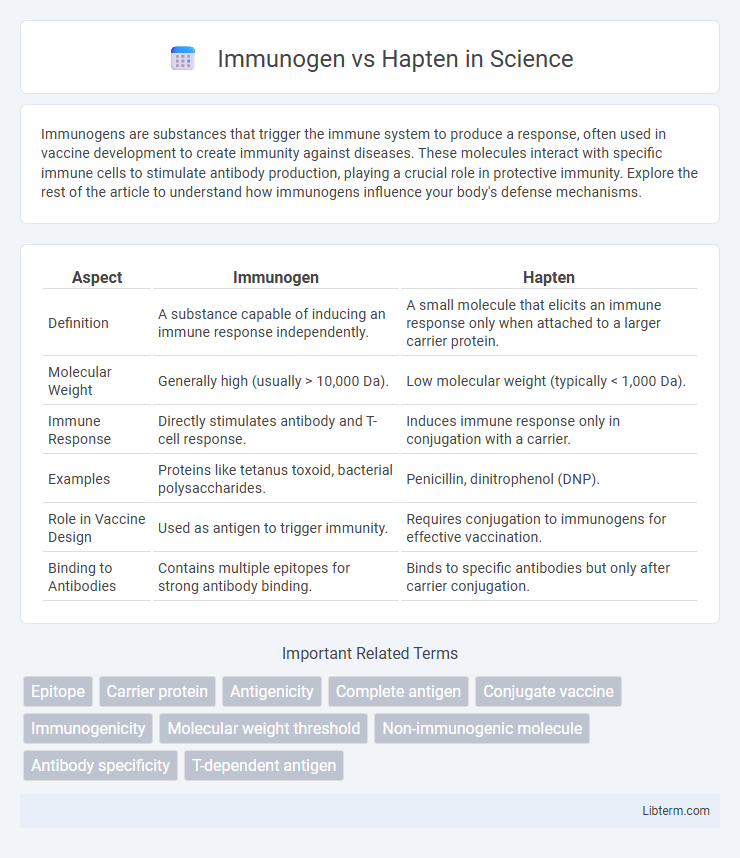Immunogens are substances that trigger the immune system to produce a response, often used in vaccine development to create immunity against diseases. These molecules interact with specific immune cells to stimulate antibody production, playing a crucial role in protective immunity. Explore the rest of the article to understand how immunogens influence your body's defense mechanisms.
Table of Comparison
| Aspect | Immunogen | Hapten |
|---|---|---|
| Definition | A substance capable of inducing an immune response independently. | A small molecule that elicits an immune response only when attached to a larger carrier protein. |
| Molecular Weight | Generally high (usually > 10,000 Da). | Low molecular weight (typically < 1,000 Da). |
| Immune Response | Directly stimulates antibody and T-cell response. | Induces immune response only in conjugation with a carrier. |
| Examples | Proteins like tetanus toxoid, bacterial polysaccharides. | Penicillin, dinitrophenol (DNP). |
| Role in Vaccine Design | Used as antigen to trigger immunity. | Requires conjugation to immunogens for effective vaccination. |
| Binding to Antibodies | Contains multiple epitopes for strong antibody binding. | Binds to specific antibodies but only after carrier conjugation. |
Introduction to Immunogens and Haptens
Immunogens are substances capable of inducing a specific immune response by activating lymphocytes, typically proteins or large polysaccharides with a high molecular weight. Haptens are small molecules that are not immunogenic alone but can elicit an immune response only when covalently attached to a larger carrier molecule. The distinction between immunogens and haptens is crucial for vaccine design and understanding antigen-antibody interactions.
Defining Immunogens
Immunogens are substances capable of inducing a robust immune response by activating lymphocytes and generating antibodies, whereas haptens are small molecules that alone cannot provoke immunity but can do so when attached to a larger carrier protein. Immunogens possess larger molecular weights and complex structures that are recognized by the immune system as foreign, leading to immunogenicity. The distinction lies in immunogens' inherent ability to elicit an adaptive immune response without modification, unlike haptens requiring conjugation to become immunogenic.
Defining Haptens
Haptens are small molecules that, unlike immunogens, cannot elicit an immune response on their own because they are not immunogenic. When coupled with a larger carrier protein, haptens become capable of inducing antibody production by the immune system. This property distinguishes haptens from immunogens, which inherently possess the ability to stimulate a full immune response independently.
Structural Differences: Immunogen vs Hapten
Immunogens are large, complex molecules, typically proteins, capable of inducing a strong immune response on their own due to their high molecular weight and structural complexity. Haptens are small, low molecular weight molecules that cannot trigger an immune response independently and must covalently bind to a larger carrier protein to become immunogenic. The key structural difference lies in size and complexity: immunogens possess extensive epitopes recognizable by immune cells, whereas haptens lack this complexity and require conjugation to a carrier for effective antigen presentation.
Mechanisms of Immune Activation
Immunogens stimulate a robust immune response by directly activating both B and T lymphocytes through antigen presentation and subsequent clonal expansion, leading to antibody production and cell-mediated immunity. Haptens, though not immunogenic alone, bind covalently to carrier proteins, forming hapten-carrier complexes that are then recognized by immune cells, enabling helper T cell activation and antibody generation specific to the hapten. The distinction in immune activation mechanisms lies in immunogens triggering primary immune recognition independently, whereas haptens depend on conjugation with larger molecules to elicit a measurable immune response.
Immunogenicity: Key Factors and Impacts
Immunogens elicit strong immune responses by containing large molecular sizes, structural complexity, and foreignness, which facilitate antigen processing and presentation. Haptens, being small molecules, lack inherent immunogenicity but can provoke an immune response when conjugated to carrier proteins, enabling recognition by immune cells. The immunogenicity depends heavily on molecular size, structural complexity, and the ability to be processed and presented by antigen-presenting cells, directly impacting vaccine design and antibody production.
Hapten-Carrier Complex: Role in Immune Response
Haptens are small molecules that, by themselves, are not immunogenic but become capable of eliciting an immune response when attached to a larger carrier protein, forming a hapten-carrier complex. The immune system recognizes the hapten-carrier complex as a novel antigen, prompting the activation of B cells and T cells, leading to antibody production specifically targeting the hapten. This mechanism underlies many allergic reactions and is crucial for the development of conjugate vaccines that enhance immunogenicity through hapten presentation.
Real-World Examples of Immunogens and Haptens
Immunogens such as the influenza virus and the Bacillus Calmette-Guerin (BCG) vaccine provoke a strong immune response due to their complex molecular structures. Haptens like penicillin and poison ivy urushiol are small molecules that become antigenic only after binding to carrier proteins, triggering allergic reactions. These real-world examples highlight the distinction where immunogens independently stimulate immunity, whereas haptens require coupling with larger molecules to elicit an immune response.
Clinical and Research Applications
Immunogens induce a robust immune response by activating both B and T lymphocytes, making them essential for vaccine development and immunotherapy research. Haptens, which are small molecules unable to elicit immunity alone, become immunogenic only when conjugated to larger carrier proteins, facilitating their use in drug allergy testing and autoimmune disease modeling. In clinical diagnostics, haptens aid in identifying specific antibody responses, while immunogens are crucial in generating monoclonal antibodies for targeted treatments and experimental vaccines.
Summary: Comparing Immunogens and Haptens
Immunogens are substances capable of inducing a strong immune response by themselves, typically proteins or large polysaccharides with high molecular weight. Haptens are small molecules that lack immunogenicity on their own but can elicit an immune response when conjugated to a larger carrier protein. The key difference lies in immunogens directly activating the immune system, while haptens require attachment to a carrier to become immunogenic.
Immunogen Infographic

 libterm.com
libterm.com